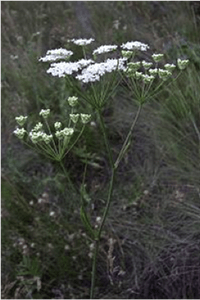Scientific name: Perideridia gairdneri
Native American Names: ayepaws (Klamath-Modoc, present usage), gaash (Klamath-Modoc historical usage), nits-ik-opa (Blackfoot)
Plant family: Apiacae, (Carrot-Parsley)
Description: Yampah is a slender, hairless perennial, 1 to 3 feet tall, with a tuberous-thickened root and leafy stems. Leaves are well distributed along the stem, are linear, 1- to 6-inches long, and pinnately divided into three to seven grass-like segments. Yampah produces umbles of white flowers which bloom in May-July. Fruits are nearly spherical, 2-3mm long and wide, slightly flattened, hairless and prominently ribbed. Roots of yampah are thumb-sized and light brown, resembling an almond.
Habitat and Range: Yampah is widely distributed across Western North America and Northern Mexico.[1] It grows on the moist edges of open hillsides, in moist open forest, in meadows, and on mossy or grassy slopes. It is found at low to middle elevations, up to about 7,500 feet. In southern Oregon, it grows in high desert meadows and in scab rock flats.
Historical and Contemporary Uses: Yampah is a traditional food of several Native American tribes. The roots were eaten and/or used as medicine by the Straits Salish[2], the Klamath and Modoc, and the Blackfoot, Paiute and the Cheyenne Nations.[3] Yampah root can be eaten boiled, raw, steamed, roasted and dried, made into a mush or pinole, and used as a flour or a flavoring.
Yampah, which they call ayepaws or gaash, was very important to the diet of both the Klamath and Modoc people. The roots, which are crunchy, sweet and nutty, were traditionally harvested during a short period of time in the late spring and early summer, while the ground was still soft and they were easier to dig.[4] They traditionally cleaned the roots at the place they were harvested. This ensured that the rootlets would be returned to the ground, rather than be discarded off-site. The ayepaws gatherers also cultivated the plant by intentionally leaving behind seeds, knocking seeds to the ground as they pulled up the roots and by weeding competing species out of the ayepaws plots. “You’re really cultivating the seed when you’re digging them up.” [4] Additionally, yampah was scattered over the ground in ceremonial offerings. It is likely that this practice also served to replant desirable roots over the freshly turned earth for later cultivation.
Photo: Deur, D. “‘A Caretaker Responsibility’: Revisiting Klamath and Modoc Traditions of Plant Community Management.” Journal of Ethnobiology, 29.2 (2009): 296-322.


